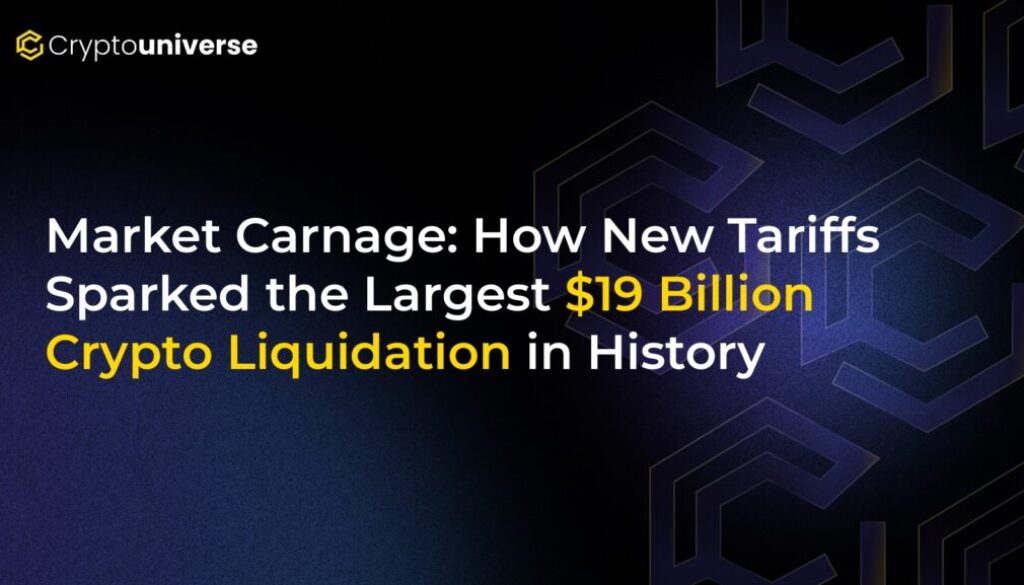Market Carnage: How New Tariffs Sparked the Largest $19 Billion Crypto Liquidation in History

A Black Friday for Crypto: Market Reels from Historic Liquidation Event
The global financial markets were thrown into turmoil on Friday, and the cryptocurrency space was at the epicenter of the shockwave. In an unprecedented event, the crypto market witnessed its largest-ever liquidation, with a staggering $19 billion in leveraged positions wiped out in a matter of hours. The catalyst? A dramatic escalation in the US-China trade war, spearheaded by President Trump’s announcement of a 100% tariff hike on Chinese imports and stringent new export controls.
The sudden move sent waves of panic across all asset classes, from stocks to oil, but the highly leveraged crypto derivatives market bore the brunt of the impact. Major cryptocurrencies like Bitcoin (BTC) and Ethereum (ETH) saw their prices plummet, triggering a cascade of forced liquidations that erased billions from the market and left traders reeling.
The Geopolitical Trigger: Understanding the Tariff Shock
To understand the crypto market’s violent reaction, we must look at the macroeconomic trigger. President Trump’s decision to impose a 100% tariff on key Chinese goods represents a significant and aggressive escalation of trade tensions between the world’s two largest economies. This isn’t just a minor policy tweak; it’s a move that threatens to disrupt global supply chains, increase consumer costs, and slow down economic growth.
Such geopolitical uncertainty creates a classic “risk-off” environment. Investors, fearing a global recession, rush to sell assets they perceive as risky—like stocks and cryptocurrencies—and move their capital into safer havens like government bonds or cash. This flight to safety was a primary driver of the massive sell-off.
Unpacking the <$19 Billion Crypto Liquidation>
What is a Liquidation in Crypto?
For those new to the space, a liquidation event of this scale can be confusing. It primarily relates to leveraged trading, a high-risk, high-reward strategy. Here’s a simple breakdown:
- Leverage: Traders borrow funds from an exchange to open a much larger position than their own capital would allow. For example, with 10x leverage, a $1,000 investment can control a $10,000 position.
- The Risk: While profits are magnified, so are losses. If the market moves against the trader’s position by a small margin, their initial investment (collateral) can be completely wiped out.
- Liquidation: When losses reach a certain point, the exchange automatically force-sells the trader’s position to cover the loan and prevent further losses. This is a liquidation.
Friday’s news caused a rapid price drop, which triggered a domino effect. As prices fell, initial long positions were liquidated, creating more selling pressure, which pushed prices down further, liquidating even more positions. This is known as a “long squeeze,” and it’s what led to the historic $19 billion wipeout.
Bitcoin and Ethereum at the Heart of the Storm
As the market leaders, Bitcoin and Ethereum saw the most significant losses. The sudden price crash caught countless over-leveraged traders off guard. The rapid descent demonstrated just how quickly fortunes can change in the volatile crypto market, especially when macroeconomic fears take hold.
The Bigger Picture: Crypto is No Longer an Island
This event serves as a stark reminder that the cryptocurrency market does not exist in a vacuum. The narrative of Bitcoin as an uncorrelated “digital gold” or a perfect hedge against traditional market turmoil is being seriously tested. As more institutional capital has entered the space, crypto has become increasingly intertwined with the global financial system.
Consequently, it is now highly sensitive to the same geopolitical and macroeconomic pressures that affect stocks, commodities, and currencies. A trade war between the US and China is no longer a distant concern for crypto investors; as we saw on Friday, it can be a direct and devastating catalyst for market volatility.
What’s Next? Brace for More Volatility
With the US-China trade war deepening, investors across all markets are bracing for a period of heightened uncertainty and volatility. For the crypto market, this means the potential for more wild price swings is high.
This historic liquidation event is a painful lesson in risk management. It underscores the dangers of using high leverage, especially during times of geopolitical instability. As the market attempts to find its footing, traders and investors would be wise to proceed with caution, stay informed on global events, and prepare for a potentially rocky road ahead.


